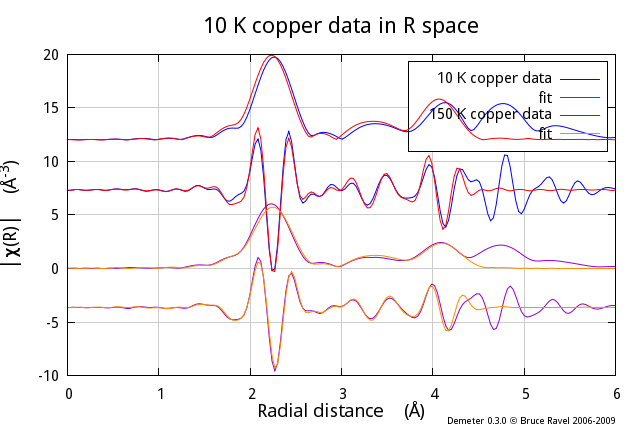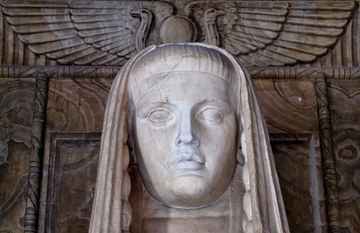10.1. Setting up a fit¶
In this section, the examples will reinforce the idea that the Fit
object is simply a collection of Data, Path, and GDS objects. We have
already seen some of this. To make a fit, a number of GDS object are
created and the gds attribute of the Fit object is set to an
anonymous array containing those GDS objects. Similarly, the paths
attribute is set to an anonymous array containing all the Path objects
to be used in the fit. This idea of a Fit object containing a
collection of other objects extends to its use for more advanced
fitting concepts. A Fit object for a multiple data set fit has its
data attribute set to an anonymous list of Data objects. This is
shown in the first example below. A Fit object involving multiple
FEFF calculations is made by creating some number of Path
objects from each FEFF calculation, then collecting all
those Path objects into the paths attribute of the Fit
object. This is shown in the second example below.
10.1.1. Multiple data set fitting¶
The following script expands upon the example in the previous section by expanding the isotropic expansion and correlated Debye fitting model to a simultaneous refinement of two data sets. In this example, two copper foils measurements were made at 10 K and 150 K. Both are imported from an ATHENA project file and a Fit object is established using both data sets.
1 2 3 4 5 6 7 8 9 10 11 12 13 14 15 16 17 18 19 20 21 22 23 24 25 26 27 28 29 30 31 32 33 34 35 36 37 38 39 40 41 42 43 44 45 46 47 48 49 50 51 52 53 54 55 56 57 58 59 60 61 62 63 64 65 66 67 68 69 70 71 72 | #!/usr/bin/perl
use Demeter qw(:ui=screen);
## import an Athena project file with copper metal in it
my $prj = Demeter::Data::Prj->new(file='cu_data.prj');
## make a Data object and set the FT and fit parameters
my @data = $prj->records(1, 2);
$data[0] -> name('10 K copper data');
$data[1] -> name('150 K copper data');
my @common = (fft_kmin => 3, fft_kmax => 14,
fit_k1 => 1, fit_k3 => 1,
bft_rmin => 1.6, bft_rmax => 4.3,
fit_do_bkg => 0,
);
$_ -> set(@common) foreach @data;
## run a Feff calculation on copper metal
my $feff = Demeter::Feff -> new(file => "cu_metal.inp");
$feff -> set(workspace => "cu_workspace/", screen => 0,);
$feff -> potph -> pathfinder;
my @list_of_paths = $feff-> list_of_paths;
## make GDS objects for an isotropic expansion, correlated Debye model fit to copper
my @gds = (Demeter::GDS -> new(gds => 'guess', name => 'alpha10', mathexp => 0),
Demeter::GDS -> new(gds => 'guess', name => 'alpha150', mathexp => 0),
Demeter::GDS -> new(gds => 'guess', name => 'amp', mathexp => 1),
Demeter::GDS -> new(gds => 'guess', name => 'enot', mathexp => 0),
Demeter::GDS -> new(gds => 'guess', name => 'theta', mathexp => 500),
Demeter::GDS -> new(gds => 'set', name => 'sigmm', mathexp => 0.00052),
);
## make Path objects for the first 5 paths in copper (3 shell fit)
my @paths = ();
foreach my $i (0 .. 4) {
## paths for data at 10K
$paths[$i] = Demeter::Path -> new();
$paths[$i]->set(data => $data[0],
sp => $list_of_paths[$i];
s02 => 'amp',
e0 => 'enot',
delr => 'alpha10*reff',
sigma2 => 'debye(10, theta) + sigmm',
);
## paths for data at 150K
my $j = $i+5;
$paths[$j] = $paths[$i] -> Clone;
$paths[$j] -> set(data => $data[1],
delr => 'alpha150*reff',
sigma2 => 'debye(150, theta) + sigmm',
);
};
## make a Fit object
my $fit = Demeter::Fit -> new(gds => \@gds,
data => \@data,
paths => \@paths
);
## do the fit
$fit -> fit;
## set up some plotting parameters
$data[0] -> po -> set(plot_data => 1, plot_fit => 1,
plot_bkg => 0, plot_res => 0,
plot_win => 0, plot_run => 0,
kweight => 2,
);
$data[0] -> y_offset(6);
$_ -> plot('rmr') foreach @data;
$data[0] -> pause;
|
This script bears a strong resemblance to the one in the previous
section. There are a couple of small differences. At lines 8-16, two
records are imported from the ATHENA project file. They
both have parameters set appropriately. One fewer GDS object at lines
19-25 is defined compared to the previous script. This is because the
temperature parameter of IFEFFIT's debye function is
explicitly set to the correct value at lines 43 and 51.
The major difference of this multiple data set fitting model is at
line 57. Both Data objects are supplied to the Fit object. This is the
fundamental difference between a single and multiple data set fit –
the number of items in the Fit object's data attribute. Very cool!
Another major difference is shown at lines 47-52. In those lines a set
of Path objects is set up and associated with the second Data object. At
lines 37-44, Path objects are set up for the 10 K data in identical
manner to the script in the previous section. At line 48, each Path
object is cloned, returning a new Path object with all the same
attributes. These copies are added to the @paths list, with care
taken at line 47 to do the counting correctly. In lines 49-52, only
those parameters that need to be changed to be appropriate for the 150 K
data set are set to their new values. At line 49, the cloned paths are
associated with the 150 K Data object. At lines 50 and 51, the
temperature dependent path parameters are set appropriately.
Note that the sp atrtibute is not changed for the cloned
paths. This is central to DEMETER's efficient use of
FEFF. The same ScatteringPath object is used for the Path
object associated with the 10 K Data object and for the Path
object associated with the 150 K Data object. This is conceptually
equivalent to using the same feffNNNN.dat file in two
different path paragraphs in a FEFFIT input file.

Fig. 10.2 Another impoirtant thing demonstrated by this example is how a fairly elaborate polot can be generated with a small number of lines of code. The plot to the right is what gets made by lines 65-71. Lines 65-69 set some parameters of the Plot object. Line 70 sets a vertical offset for the plot of the 10 K data. At line 71 Rmr plots are made for each Data object. That's a lot of plot for two lines of code!
10.1.2. Using multiple Feff calculations¶
DEMETER is copyright © 2009-2016 Bruce Ravel – This document is copyright © 2016 Bruce Ravel
This document is licensed under The Creative Commons Attribution-ShareAlike License.
If DEMETER and this document are useful to you, please consider supporting The Creative Commons.
